There's More to Life Than Being Happy
 |  |
There's More to Life Than Being Happy
"It is the very pursuit of happiness that thwarts happiness."

In September 1942, Viktor Frankl, a prominent Jewish psychiatrist and neurologist in Vienna, was arrested and transported to a Nazi concentration camp with his wife and parents. Three years later, when his camp was liberated, most of his family, including his pregnant wife, had perished -- but he, prisoner number 119104, had lived. In his bestselling 1946 book, Man's Search for Meaning, which he wrote in nine days about his experiences in the camps, Frankl concluded that the difference between those who had lived and those who had died came down to one thing: Meaning, an insight he came to early in life. When he was a high school student, one of his science teachers declared to the class, "Life is nothing more than a combustion process, a process of oxidation." Frankl jumped out of his chair and responded, "Sir, if this is so, then what can be the meaning of life?"
As he saw in the camps, those who found meaning even in the most horrendous circumstances were far more resilient to suffering than those who did not. "Everything can be taken from a man but one thing," Frankl wrote in Man's Search for Meaning, "the last of the human freedoms -- to choose one's attitude in any given set of circumstances, to choose one's own way."
Frankl worked as a therapist in the camps, and in his book, he gives the example of two suicidal inmates he encountered there. Like many others in the camps, these two men were hopeless and thought that there was nothing more to expect from life, nothing to live for. "In both cases," Frankl writes, "it was a question of getting them to realize that life was still expecting something from them; something in the future was expected of them." For one man, it was his young child, who was then living in a foreign country. For the other, a scientist, it was a series of books that he needed to finish. Frankl writes:
 Viktor Frankl [Herwig Prammer/Reuters] Viktor Frankl [Herwig Prammer/Reuters]
In 1991, the Library of Congress and Book-of-the-Month Club listedMan's Search for Meaning as one of the 10 most influential books in the United States. It has sold millions of copies worldwide. Now, over twenty years later, the book's ethos -- its emphasis on meaning, the value of suffering, and responsibility to something greater than the self -- seems to be at odds with our culture, which is more interested in the pursuit of individual happiness than in the search for meaning. "To the European," Frankl wrote, "it is a characteristic of the American culture that, again and again, one is commanded and ordered to 'be happy.' But happiness cannot be pursued; it must ensue. One must have a reason to 'be happy.'"
According to Gallup , the happiness levels of Americans are at a four-year high -- as is, it seems, the number of best-selling books with the word "happiness" in their titles. At this writing, Gallup also reports that nearly 60 percent all Americans today feel happy without a lot of stress or worry. On the other hand, according to the Center for Disease Control, about 4 out of 10 Americans have not discovered a satisfying life purpose. Forty percent either do not think their lives have a clear sense of purpose or are neutral about whether their lives have purpose. Nearly a quarter of Americans feel neutral or do not have a strong sense of what makes their lives meaningful. Research has shown that having purpose and meaning in life increases overall well-being and life satisfaction, improves mental and physical health, enhances resiliency, enhances self-esteem, and decreases the chances of depression. On top of that, the single-minded pursuit of happiness is ironically leaving people less happy, according to recent research. "It is the very pursuit of happiness," Frankl knew, "that thwarts happiness."
***
This is why some researchers are cautioning against the pursuit of mere happiness. In a new study, which will be published this year in a forthcoming issue of theJournal of Positive Psychology, psychological scientists asked nearly 400 Americans aged 18 to 78 whether they thought their lives were meaningful and/or happy. Examining their self-reported attitudes toward meaning, happiness, and many other variables -- like stress levels, spending patterns, and having children -- over a month-long period, the researchers found that a meaningful life and happy life overlap in certain ways, but are ultimately very different. Leading a happy life, the psychologists found, is associated with being a "taker" while leading a meaningful life corresponds with being a "giver."
"Happiness without meaning characterizes a relatively shallow, self-absorbed or even selfish life, in which things go well, needs and desire are easily satisfied, and difficult or taxing entanglements are avoided," the authors write.
How do the happy life and the meaningful life differ? Happiness, they found, is about feeling good. Specifically, the researchers found that people who are happy tend to think that life is easy, they are in good physical health, and they are able to buy the things that they need and want. While not having enough money decreases how happy and meaningful you consider your life to be, it has a much greater impact on happiness. The happy life is also defined by a lack of stress or worry.
Most importantly from a social perspective, the pursuit of happiness is associated with selfish behavior -- being, as mentioned, a "taker" rather than a "giver." The psychologists give an evolutionary explanation for this: happiness is about drive reduction. If you have a need or a desire -- like hunger -- you satisfy it, and that makes you happy. People become happy, in other words, when they get what they want. Humans, then, are not the only ones who can feel happy. Animals have needs and drives, too, and when those drives are satisfied, animals also feel happy, the researchers point out.
"Happy people get a lot of joy from receiving benefits from others while people leading meaningful lives get a lot of joy from giving to others," explained Kathleen Vohs, one of the authors of the study, in a recent presentation at the University of Pennsylvania. In other words, meaning transcends the self while happiness is all about giving the self what it wants. People who have high meaning in their lives are more likely to help others in need. "If anything, pure happiness is linked to not helping others in need," the researchers write.
What sets human beings apart from animals is not the pursuit of happiness, which occurs all across the natural world, but the pursuit of meaning, which is unique to humans, according to Roy Baumeister, the lead researcher of the study and author, with John Tierney, of the recent book Willpower: Rediscovering the Greatest Human Strength. Baumeister, a social psychologists at Florida State University,was named an ISI highly cited scientific researcher in 2003.
The study participants reported deriving meaning from giving a part of themselves away to others and making a sacrifice on behalf of the overall group. In the words of Martin E. P. Seligman, one of the leading psychological scientists alive today, in the meaningful life "you use your highest strengths and talents to belong to and serve something you believe is larger than the self." For instance, having more meaning in one's life was associated with doing activities like buying presents for others, taking care of kids, and arguing. People whose lives have high levels of meaning often actively seek meaning out even when they know it will come at the expense of happiness. Because they have invested themselves in something bigger than themselves, they also worry more and have higher levels of stress and anxiety in their lives than happy people. Having children, for example, is associated with the meaningful life and requires self-sacrifice, but it has been famously associated with low happiness among parents, including the ones in this study. In fact, according to Harvard psychologist Daniel Gilbert, research shows that parents are less happy interacting with their children than they are exercising, eating, and watching television.
"Partly what we do as human beings is to take care of others and contribute to others. This makes life meaningful but it does not necessarily make us happy," Baumeister told me in an interview.
Meaning is not only about transcending the self, but also about transcending the present moment -- which is perhaps the most important finding of the study, according to the researchers. While happiness is an emotion felt in the here and now, it ultimately fades away, just as all emotions do; positive affect and feelings of pleasure are fleeting. The amount of time people report feeling good or bad correlates with happiness but not at all with meaning.
Meaning, on the other hand, is enduring. It connects the past to the present to the future. "Thinking beyond the present moment, into the past or future, was a sign of the relatively meaningful but unhappy life," the researchers write. "Happiness is not generally found in contemplating the past or future." That is, people who thought more about the present were happier, but people who spent more time thinking about the future or about past struggles and sufferings felt more meaning in their lives, though they were less happy.
Having negative events happen to you, the study found, decreases your happiness but increases the amount of meaning you have in life. Another study from 2011 confirmed this, finding that people who have meaning in their lives, in the form of a clearly defined purpose, rate their satisfaction with life higher even when they were feeling bad than those who did not have a clearly defined purpose. "If there is meaning in life at all," Frankl wrote, "then there must be meaning in suffering."
***
Which brings us back to Frankl's life and, specifically, a decisive experience he had before he was sent to the concentration camps. It was an incident that emphasizes the difference between the pursuit of meaning and the pursuit of happiness in life.
 Peter Andrews/Reuters Peter Andrews/Reuters
In his early adulthood, before he and his family were taken away to the camps, Frankl had established himself as one of the leading psychiatrists in Vienna and the world. As a 16-year-old boy, for example, he struck up a correspondence with Sigmund Freud and one day sent Freud a two-page paper he had written. Freud, impressed by Frankl's talent, sent the paper to the International Journal of Psychoanalysis for publication. "I hope you don't object," Freud wrote the teenager.
While he was in medical school, Frankl distinguished himself even further. Not only did he establish suicide-prevention centers for teenagers -- a precursor to his work in the camps -- but he was also developing his signature contribution to the field of clinical psychology: logotherapy, which is meant to help people overcome depression and achieve well-being by finding their unique meaning in life. By 1941, his theories had received international attention and he was working as the chief of neurology at Vienna's Rothschild Hospital, where he risked his life and career by making false diagnoses of mentally ill patients so that they would not, per Nazi orders, be euthanized.
That was the same year when he had a decision to make, a decision that would change his life. With his career on the rise and the threat of the Nazis looming over him, Frankl had applied for a visa to America, which he was granted in 1941. By then, the Nazis had already started rounding up the Jews and taking them away to concentration camps, focusing on the elderly first. Frankl knew that it would only be time before the Nazis came to take his parents away. He also knew that once they did, he had a responsibility to be there with his parents to help them through the trauma of adjusting to camp life. On the other hand, as a newly married man with his visa in hand, he was tempted to leave for America and flee to safety, where he could distinguish himself even further in his field.
As Anna S. Redsand recounts in her biography of Frankl, he was at a loss for what to do, so he set out for St. Stephan's Cathedral in Vienna to clear his head. Listening to the organ music, he repeatedly asked himself, "Should I leave my parents behind?... Should I say goodbye and leave them to their fate?" Where did his responsibility lie? He was looking for a "hint from heaven."
When he returned home, he found it. A piece of marble was lying on the table. His father explained that it was from the rubble of one of the nearby synagogues that the Nazis had destroyed. The marble contained the fragment of one of the Ten Commandments -- the one about honoring your father and your mother. With that, Frankl decided to stay in Vienna and forgo whatever opportunities for safety and career advancement awaited him in the United States. He decided to put aside his individual pursuits to serve his family and, later, other inmates in the camps.
RECOMMENDED
The wisdom that Frankl derived from his experiences there, in the middle of unimaginable human suffering, is just as relevant now as it was then: "Being human always points, and is directed, to something or someone, other than oneself -- be it a meaning to fulfill or another human being to encounter. The more one forgets himself -- by giving himself to a cause to serve or another person to love -- the more human he is."
Baumeister and his colleagues would agree that the pursuit of meaning is what makes human beings uniquely human. By putting aside our selfish interests to serve someone or something larger than ourselves -- by devoting our lives to "giving" rather than "taking" -- we are not only expressing our fundamental humanity, but are also acknowledging that that there is more to the good life than the pursuit of simple happiness.

It is easy to say that the Germans, having perpetrated some of the most appalling atrocities in human history, had brought their suffering on themselves. The general rule, though, was that the further east you went, the worse the horror became. In Prague, captured German soldiers were ‘beaten, doused in petrol and burned to death’. In the city’s sports stadium, Russian and Czech soldiers gang-raped German women. In the villages of Bohemia and Moravia, hundreds of German families were brutally butchered. And in Polish prisons, German inmates were drowned face down in manure, and one man reportedly choked to death after being forced to swallow a live toad. Yet at the time, many people saw this as just punishment for the Nazis’ crimes. Allied leaders refused to discuss the atrocities, far less condemn them, because they did not want to alienate public support. ‘When you chop wood,’ the future Czech president, Antonin Zapotocky, said dismissively, ‘the splinters fly.’ It is to Lowe’s great credit that he resists the temptation to sit in moral judgment. None of us can know how we would have behaved under similar circumstances; it is one of the great blessings of British history that, despite our sacrifice to beat the Nazis, our national experience was much less traumatic than that of our neighbours. It is also true that repellent as we might find it, the desire for revenge was both instinctive and understandable — especially in those terrible places where the Nazis had slaughtered so many innocents. So it is shocking, but not altogether surprising, to read that when the Americans liberated the Dachau death camp, a handful of GIs lined up scores of German guards and simply machine-gunned them.

We in Britain are right to be proud of our record in the war. Yet it is time that we faced up to some of the unsettling moral ambiguities of those bloody, desperate years. By any standards this was a war crime; yet who among us can honestly say we would have behaved differently? Lowe notes how ‘a very small number’ of Jewish prisoners wreaked a bloody revenge on their former captors. Such claims, inevitably, are deeply controversial. When the veteran American war correspondent John Sack, himself Jewish, wrote a book about it in the 1990s, he was accused of Holocaust denial and his publishers cancelled the contract. Yet after the liberation of Theresienstadt camp, one Jewish man saw a mob of ex-inmates beating an SS man to death, and such scenes were not uncommon across the former Reich. ‘We all participated,’ another Jewish camp inmate, Szmulek Gontarz, remembered years later. ‘It was sweet. The only thing I’m sorry about is that I didn’t do more.’ Meanwhile, across great swathes of Eastern Europe, German communities who had lived quietly for centuries were being driven out. Some had blood on their hands; many others, though, were blameless. But they could not have paid a higher price for the collapse of Adolf Hitler’s imperial ambitions. In the months after the war ended, a staggering 7 million Germans were driven out of Poland, another 3 million from Czechoslovakia and almost 2 million more from other central European countries, often in appalling conditions of hunger, thirst and disease.
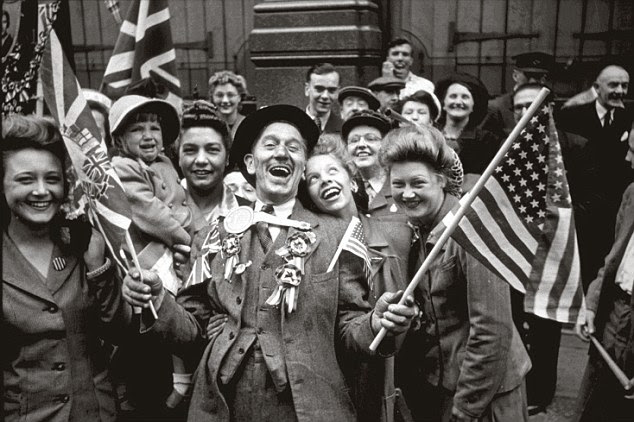
Joyous: When we picture the end of the war, we imagine crowds in central London, cheering and singing. Today this looks like ethnic cleansing on a massive scale. Yet at the time, conscious of all they had endured under the Nazi jackboot, Polish and Czech politicians saw the expulsions as ‘the least worst’ way to avoid another war. Indeed, this ethnic savagery was not confined to the Germans.
|  Albania. Tirana . for her first visit in Albania, Mother theresa is welcomed by the father Zeff Pelumbi on Tirana Airport 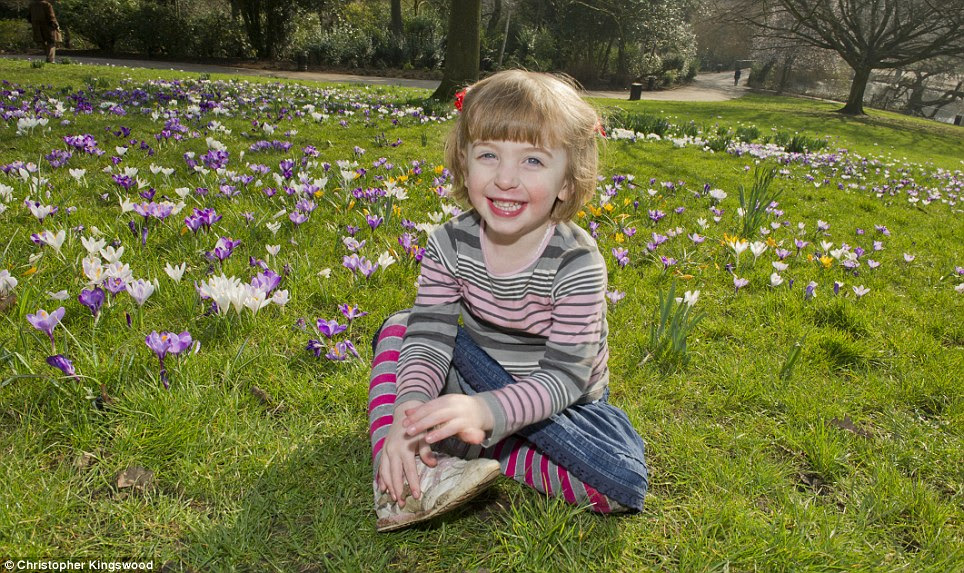 Joys of spring: Three-year-old Beatrice Ryan plays among the blooming crocuses in Waterlow Park in North London No matter how much money you have you are NEVER happy: Even millionaires say they need to at least double their wealth to be truly content, first study of its kind finds
It's official: money doesn't buy you happiness.
Even millionaires think genuine pleasure is out of reach, despite their fortune - and can only be achieved through even greater wealth.
Moreover, many believe they'd need at least double their net worth to be content.
Researchers at Harvard Business School quizzed 2,000 millionaires for the study, which is considered to be the first of its kind to focus solely on this level of wealth.

How much is enough? A quarter of millionaires worth $1.5 million (£1.18 million) said that they'd need eleven times more money to be perfectly happy, despite their wealth (stock image)
Professor Michael Norton, who led the research, asked subjects - the wealthiest clients of an investment bank - to rank their happiness on a scale of one to ten.
He then asked them to specify what net worth would be required for them to reach optimum levels of contentment.
'Basically everyone says [they’d need] two or three times as much [money],' Professor Norton told The Atlantic magazine.
Specifically, a quarter of millionaires worth $1.5 million (£1.18 million) said they'd need eleven times more money to be perfectly happy, while one quarter said they would need six times as much.
Another quarter said they would need twice as much money to finally be happy.nterestingly, this 'did not differ by wealth' and the perceived need that more money equates to more happiness was expressed even by those with a net worth of more than $7.6million (£6 million).
'Our results suggest that the curve does not fully flatten out,' Professor Norton added.
Similarly, millionaires with wealth of more than £6 million were found to be happier than those with about £1 million, but this only provided 'modestly greater well-being', the study said.
However, those who earned their fortune were happier than those who merely inherited it, suggesting that accomplishing goals is key to satisfaction.
The full results of the study were published in Personality and Social Psychology Bulletin.

Researchers at Harvard Business School quizzed 2,000 millionaires for the study, which is considered the first of its kind (stock image)
Previous research has suggested that money-related happiness plateaus beyond £60,000 per year, but according to some experts, the hunger for limitless wealth is real.
Jeffrey Winters, a political science professor at Northwestern University, based in Evanston, Illinois, told The Times: 'Every billionaire I’ve spoken to, and I’ve spoken to quite a number of them, is extremely excited by each additional increment of money they make.'
It comes just a few months after scientists found that social mobility is partially written into our genes, essentially determining whether we're high-flyers or high-earners.
A study of more than 20,000 people in the UK, US and New Zealand found those with certain genetic variations earned more money, had better careers and got further in education.
Regardless of which class they came from, their genes could help them do better in life than their parents before them.
A team of researchers from Duke University School of Medicine in Durham, North Carolina, undertook a genome-wide association study (GWAS) on more than 20,000 individuals from Britain, New Zealand, and the United States who were followed from childhood into adulthood.
The GWAS looked for thousands of tiny changes in genetic code in the individuals that previous studies have linked with success at school.
Unsurprisingly, they found that men and women with ‘genes for education’ - or high polygenic scores - did better academically.
But the same genes also helped make someone upwardly mobile.
Those with a high polygenic score did better in terms of education, occupation, and wealth, compared with their parents and siblings, regardless of the individuals' familial social class as children.
Lead author Dr Daniel Belsky, from the Department of Population Health Sciences at Duke University, said: ‘Findings from these analyses show that education-linked genetics may provide clues to biological processes in human development that influence success in school, at work, and in the accumulation of wealth across life.’
 People were out enjoying the crocus fields and the hot weather at Savill Gardens in Ascot today  Daffodils in full bloom at St.James's Park as Londoners enjoy spring temperatures in the capital  Not a single daffodil has bloomed for Britain's biggest Daffodil Festival after the big freeze killed off more than £1 million worth of the flowers across the country. More than 10,000 people from all over the UK visit the tiny village of Thriplow in Cambridgeshire each year to admire its hosts of golden daffodils. But this year there are no brilliant yellow blooms after a winter of topsy-turvy weather, which saw temperatures dip as low as minus 12C. Disappointed visitors, who come by the coach load from across the country, will be greeted by green stems instead of glorious swathes of daffodils. "The village is normally full of blooming daffodils by St David's Day and the lanes are bright yellow," said David Egleton, 65, from Thriplow. "But this year the stems are not very high and none have flowered. It's a real shame." The village of Thriplow, eight miles south of Cambridge, started its famous Daffodil Weekend in April 1969 to raise money to repair its church, St George's. A number of parishioners opened their gardens to the public and the first event attracted more than 1,500 visitors The tradition has since continued every year except for 2001 because of the foot and mouth outbreak.  A bee goes about its business as the sun shines on Waterlow Park in London. One of the most beautiful things in nature must surely be the sun rising and setting. When that sunset happens to align with a street grid, basking a city that never sleeps in a radiant glow of light, even busy New Yorkers would be pushed not to stop and marvel at its brilliance. It's that time of year again known as 'Manhattanhenge' - when the sun aligns precisely with the street grid in Manhattan, simultaneously illuminating both the north and south sides of every cross street of the borough's grid.  Urban phenomenon: This special day - also known as Manhattan solstice - comes twice a year, when the sun sets with half the disc sitting above and half below the horizon. The times are calculated every year by the astronomer Neil deGrasse Tyson, an astrophysicist and director of the Hayden Planetarium in New York, who coined the term 'Manhattanhenge' in 2002, named after the British Stonehenge, which celebrates summer and winter solstice. Though in New York it does not signal the solstice - the changing of the season - due to the position of Manhattan's grid. A rare photograph of Princess Diana with Mother Theresa Support: The Dubliner's owner predicted that the president could, at least on St Patrick's Day, count on the support of the millions of Americans who claim Irish ancestry  VE-Day celebration ride Keep Them Rolling 5th of may8th May 1945, VE Day, Allington Road, Southville, BristolThere were few communities around the city who did not hold a party for the local children, and this one was organised by the residents of Allington Road, Southville, Bristol.The little tot on the right has been given a ‘Shirley Temple’ hair-do to mark the occasion. Fathers as well as mothers have worked together to give the kids a day to remember. While providing the food was still recognised as ‘women’s work’ at the time, the menfolk would have provided the muscle power behind the placing of the tables and benches - and perhaps organised a few races and team games. In the end it was all worth waiting for, and the ‘V for victory sign reveals the upbeat atmosphere. The children pictured here look well fed and happy, but they had grown up on a basic E diet that held few sweets or luxuries. Clothing, too, was rationed, and people had to ‘make do and mend’ whenever they could; by the end of the war most women’s wardrobes were looking decidedly tired. Everyone was looking forward to the future, to a time when they could stop using tinned dried eggs, and shop for clothes without counting how many coupons they had. It was to be a long wait. Clothing was rationed until 1949, and sweets until 1953 - and in fact bread went on ration in 1946!It was 1954 before all rationing in Britain was ended. Brand names once more appeared on certain food products, and young people were amazed to realise that products such as margarine could be labelled as Stork or Summer County instead of just being plain old foul tasting margarine. Was it really made from whale oil?  The Green House: In a recently new tradition for the White House, the South Lawn's fountains were dyed green, similar to Chicago's tradition which is the Obama family's hometown |
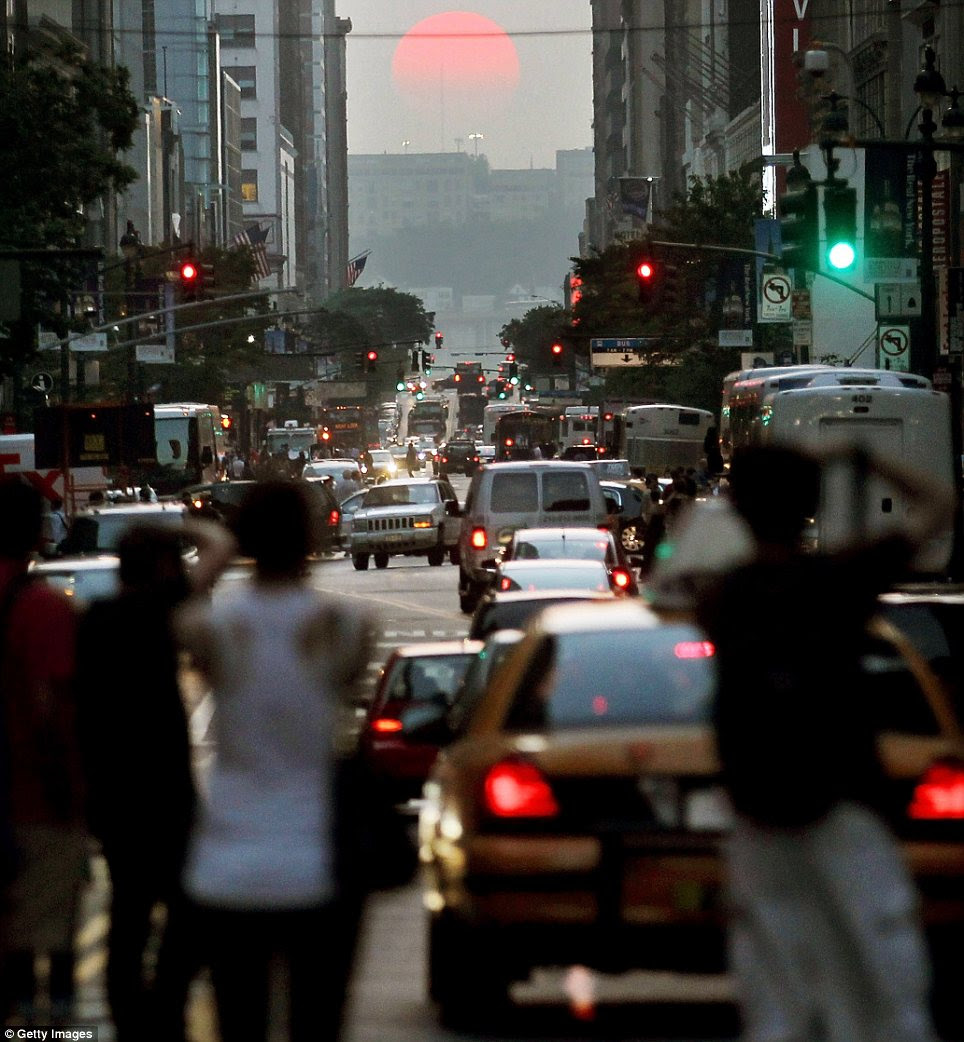
Red sky at night: New Yorkers snap the setting sun as it sets on West 34th Street during Manhattanhenge

Sun rising up: Manhattanhenge occurs when the setting sun aligns itself with the east-west grid of streets in Manhattan, allowing the sun to shine down all streets at the same time
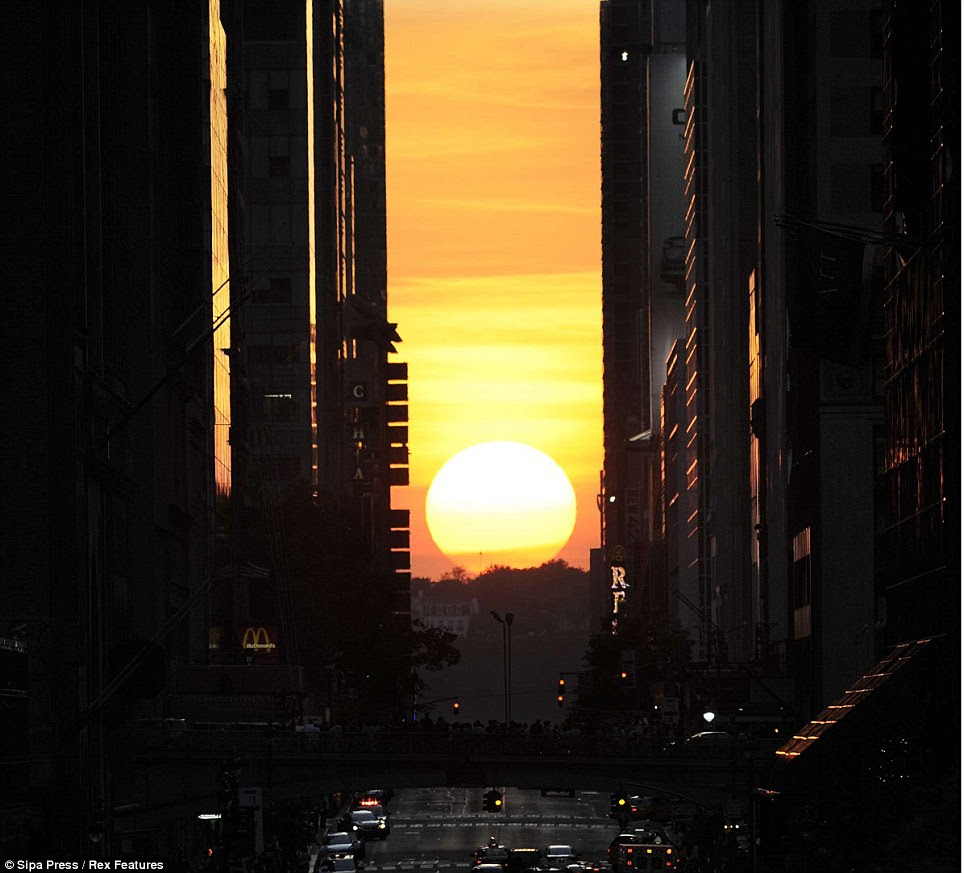
Beautiful: This occurs in Manhattan due to a clear view to the horizon beyond the grid - across the Hudson River to New Jersey - as well as the tall buildings that line the streets, creating a vertical channel to frame the sun
Mr deGrasse Tyson explains: 'In spite of what pop-culture tells you, the sun rises due east and sets due west only twice per year on the equinoxes - the first day of spring and of autumn. Every other day, the sun rises and sets elsewhere on the horizon.
'Had Manhattan's grid been perfectly aligned with the geographic north-south line, then the days of Manhattanhenge would coincide with the equinoxes. But Manhattan's street grid is rotated 30 degrees east from geographic north, shifting the days of alignment elsewhere into the calendar.'
Mr deGrasse Tyson notes that the dates correspond with Memorial day and Baseball's All Star Break.
He said: 'Future anthropologists might conclude that, via the sun, the people who called themselves Americans worshipped war and baseball.'

Capturing the moment: The spectacle drew a crowd of snappers yesterday as the sun turned from yellow to pink in perfect alinement's with New York's grid system

Namesake: Manhattanhenge is named after Stonehenge in England when the sun Sun rises in perfect alignment with several of the stones, signaling the change of season

Met Office forecaster George Goodfellow said it was set to be sunny and dry with similar temperatures throughout the week.

Summer sun: A woman enjoying Brighton beach this morning

Riding out: Rachael Foister enjoys the hot weather and spring daffodils at West Dean College, West Sussex
Mr Goodfellow said: 'A band of high pressure coming from the north-west will stay with us this week bringing with it a spell of warm weather.
'Temperatures will get up to 17 degrees across the country which is pretty warm for this time of year.
'The average temperatures are between eight and 12 degrees (46F to 53F). One or two places could get even warmer than that, particularly in the south east.'
He added there could be a chance of frost as the temperatures cool down overnight but said on the whole the next few days will remain mild.
'We won't really see anything much in the way of significant rainfall.'
But Mr Goodfellow warned that England could be on course for a drought this summer after parts of the country saw the driest February for 14 years.

Life's a beach: In Portsmouth the sun-worshippers were out on force today
Lincolnshire had one of the driest months on record after only 10mm of rain fell in the whole month while East Anglia saw just 20mm when the average rainfall for the country at this time of year is between 40 and 60mm.
'This emphasises why there are concerns about a drought. It could well happen,' said Mr Goodfellow.
The worsening drought means that 20million homes could be hit with hosepipe bans.
Water companies in the South and East of England, where rainfall has been too low for nearly two years, will announce restrictions affecting one in three homes in the UK, it is expected. Other areas could soon follow.
The move follows months of concern about the arid conditions, which have seen rivers run dry and reservoirs at record low levels.

Golden hello: The rising sun greets a dog walker on Bamburgh Beech
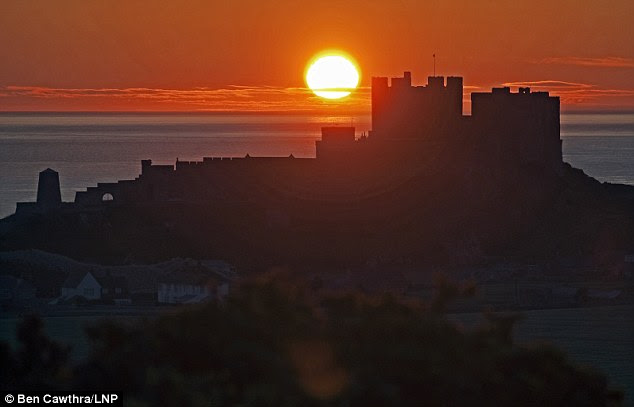
Dawn of summer: The sun rises over Bamburgh Castle in Northumberland at the start of what forecasters are predicting will be a warm week
In some areas, this has been the driest winter since records began a century or more ago, and weeks of sustained rainfall would be needed to get levels back to normal.
The Met Office is not forecasting any significant rainfall in drought-affected areas over the next month.
The announcement coincides with an Environment Agency report which will add the rest of the Midlands and Yorkshire to the area at ‘high risk’ of summer drought.
The first step companies can take is restricting the use of hosepipes and sprinklers for washing cars and watering gardens. Those who flout a hosepipe ban face a £1,000 fine.
Caps on non-essential business use such as watering golf courses, cleaning pavements and car washes could follow.
There are fears that the restrictions could affect this summer’s Olympic Games and officials are said to be drawing up contingency plans.
Looking forward to the week added, Mr Goodfellow added: 'By Thursday we could see the odd spot of rain and showers in some places as we head into the weekend and temperatures will cool down slightly getting more what we should be for this time of year.
'But it looks like it's going to be pretty nice,' he said.
The highest temperature ever recorded for March was 25 degrees (77F) in Cambridgeshire in 1968'.
I don't think we are on course to get anywhere near that but hopefully we will see a warm and sunny March,' he added.

Taking the plunge: A couple look set to brave the sea in Old Portsmouth
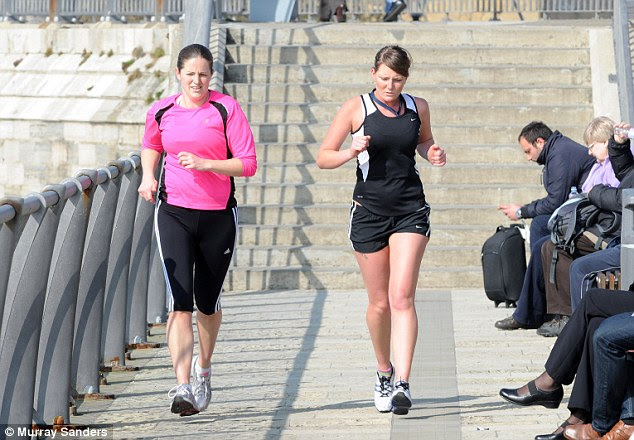
Dry run: The beautiful weather brings out the joggers in Portsmouth. Meanwhile, the weather has claimed a casualty - in the shape of Scotland’s ski season. The Scottish Children’s Ski Championships have been cancelled due to a lack of snow - and it is feared there will be no more skiiing this season. The event, which was due to take place this coming weekend at CarinGorm Mountain, was expected to attract around 200 competitors. Snowsport Scotland said that of about a dozen children’s alpine races planned this winter only one had run. None of Scotland’s five resorts were operating today and are not expected to re-open for snow sports this season. Lack of snow, mild weather and the strong winds have all been blamed for the lack of skiers on the pistes. Last year the season ended in mid-April and in 2010 it finished incredibly at the start of June.
This year the last skiing was on February 26. VERY MILD WITH LONG SUNNY SPELLS: FOUR-DAY UK FORECAST
Today: Cloudy in north-west Scotland with the chance of a little drizzle continuing. However, after a rather cloudy start, sunshine will gradually break through across south-west Scotland.
The rest of the UK will be dry with mist, fog and low cloud dispersing in most places to leave sunny periods. However, western fringes of Wales may hold onto the low cloud, mist and fog for much of the day. Feeling very mild for March.
Tuesday: Overall it will be dry for most of the day with sunny spells breaking through the mist and fog.
However, it will be generally cloudy across western Scotland and Northern Ireland with isolated spots of drizzle possible.
Wednesday: Further drizzle is possible across western Scotland, but it will be dry for the rest of the UK with sunny spells breaking through the mist and fog in most places. Staying mild on both days.
'It is unlikely there will be any more skiing this year. Even by Scottish standards it’s an unseasonably early end to the season. March is a month we have had very good skiing in previous years,' said CairnGorm Mountain spokesman Colin Kirkwood. 'We have been doing snow dances for weeks but it hasn’t worked.
'Unless there is a sudden drop in temperatures and a big snowstorm - which is not forecast - that is it for this year.'
Only 44,783 skiers and snowboarders had been logged at CairnGorm so far this season compared to 96,431 at the same time last year.
'It looks like the season is over,' said a spokesman for Snowsports Scotland. 'High temperatures and strong winds have just melted and blown away what snow there was.
The Scottish Children’s Ski Championships will not be held - it is a pity. A lack of snow has meant we have only been able to run one race this year.'
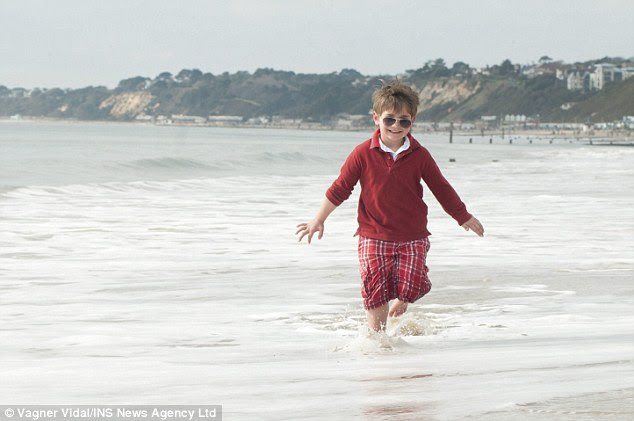
Five-year-old Leonardo Lima Hyra was enjoying the sunshine so much he braved the water on Bournemouth beach, Dorset

Two women and their dog enjoy the sunshine in Oxford next to the River Cherwell
It felt like spring had arrived early for much of the country last week.
And the unseasonably warm weather is expected to continue over the next few days, with near-record temperatures to look forward to.
Some areas could bask in conditions of up to 18c (64f) on Tuesday, and the mild weather will stay put until at least Wednesday.

'Beach weather': Masie Kennedy, aged two, plays on the sand on the beach at Bournemouth today

Sun: Two young girls run along the beach at Bournemouth today as the cloud stays away
Britain will be better off than many parts of the Mediterranean, with resorts such as Alicante in Spain expected to reach only 16.5c (62f).
Met Office forecaster Michael Lawrence said: ‘It’s going to be mild or very mild for the time of year. We’re expecting temperatures to peak on Tuesday and 17 or 18 degrees is not out of the question.
Last week the maximum temperature was 18.7c (65.7f) at Coleshill, near Birmingham, and it is possible we will see that again this week.
‘It’s possible it could go beyond that but at the moment it looks like it will just fall short.’

Winter sun: A woman takes a dip wearing only a bikini on the beach at Brighton today

Warm winter weather: Alex Kingston, aged five, with his pet dog Alfie, enjoys the remarkable warm weather in Darlington, County Durham. The last time T-shirt weather settled over Britain in February was in 1998, when temperatures reached a 100-year high of 19.7c (67.5f). The average maximum temperature for the month is around 7c (45f), while even March manages only around 10c (50f). Northern England will have the best of the weather this week, with temperatures generally a degree or two warmer than in the South. The warm conditions are in marked contrast to the below-zero temperatures and snowfall experienced by some areas of the country earlier this month. Lincolnshire, for example, saw an astonishing 33c temperature change in 12 days.
Mr Lawrence added that a ‘block area of high pressure’ similar to the one that caused the cold spell in December had been behind the chilly start to this month.‘When those break down through the month you can see the disparity in temperatures. That’s what happened this February,’ he said.

Spring bloom: Amy Eager, aged five, sat enjoying the spring sunshine on a spring patch work blanket of Crocuses in Darlington, County Durham today
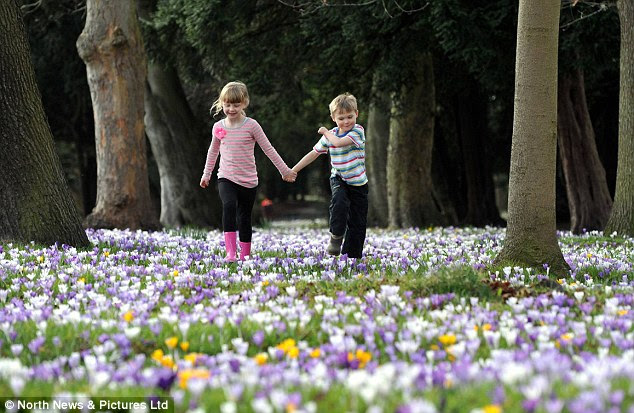
Spring: Amy Eager and Alex Kingston, both five, walk through the field of crocuses together

Warm weather: Lily Wilson, seven, enjoys the spring-like conditions at Frensham Pond, Frensham, Surrey today

Spring on its way: Oliver Lawrence, eight, splashes in the water at Frensham Pond today. Forecasters are predicting temperatures of 18C next week
There is the chance of some drizzle on Wednesday, but temperatures should not dip until the end of the week.
Despite still officially being winter, a 25-acre nursery in Titchfield, Hampshire, is bursting with colour from the spring blooms.
Each acre contains six tonnes of daffodil bulbs and the nursery grows ten different varieties.
Jon Parrett, a partner at Hollam Nursery, said: 'It's a beautiful sight to see the fields full of daffodils, especially as we had the cold snap not long ago. 'The mild winter caused us a bit of havoc and gave us early blooms in January, but then we had the snow and that finished them off. 'Now the fields are thick with daffodils so as long as the weather keeps up we'll be picking from now until the end of March.'As spring shows signs of arriving early, councils have been left with 1.5million tonnes of grit - 60 per cent of their total winter stocks.
Local authorities and the Department of Transport stockpiled a record-breaking total of more than 2.5million tonnes of grit - more than twice last winter's total - fearing a repeat of the December 2010 big freeze.
However, as this winter has turned out to be so mild, councils now have mountains worth an estimated £50million remaining.
A Local Government Association spokesman said: 'The amount of grit used so far is certainly less than last year, when councils used an estimated 1.2 million tonnes.'

Bloom: Safira Khan, 3, plays with her dad, Mohammed Khan among a stunning display of crocuses in Derby today

Sunny: Four young women enjoy the sunshine at Plymouth Hoe, Devon, today as Britain continues to enjoy an unusually warm winter

Britain in bloom: A child sits in a sea of daffodils at Hollam Nursery, in Titchfield, Hampshire today. Two weeks ago this field was covered in snow

Spring is here: This 25-acre farm will be harvested over the next few weeks. Each acre contains six tonnes of daffodils

Sea of colour: Over the next few weeks staff at Hollam Nursery will have their work cut out as they harvest the huge crop
 Gorbachevs Visit Hungary
President János Kádár (right) escorts Soviet leader Mikhail Gorbachev (left) and his wife Raisa during the couple's official visit to Hungary.
|
Last year: The sun illuminates New York's 34th Street during 2010's Manhattanhenge as well as the city's iconic Empire State Building
He explains that the reason this unique urban phenomenon occurs in Manhattan is due to a clear view to the horizon beyond the grid - as New York does across the Hudson River to New Jersey. Combine that with the tall buildings which line the streets, creating a vertical channel to frame the sun and you get a rare and striking photographic opportunity. To get the best view of this rare and beautiful sight, sun watchers need to be as far east in Manhattan as possible and look west across the avenues. The best places to get a view are the Empire State or Chrysler buildings as well as along 14th, 23rd, 34th, 42nd, and 57th Streets.
Revellers across America grabbed their green and took to the streets and bars to celebrate another St. Patrick’s Day. Spotted in the nation's capital, President Barack Obama kick started his own observance of the holiday at a boisterous Irish pub with his ancestral cousin from Moneygall, Ireland, at his side. He wore no Kelly green as he sipped a pint of Guinness among the crowd but his jacket was pierced with a button that read, 'VIP GUEST — Tell 'em Danny sent you.'

O'Bama: President Barack Obama celebrated at the Dubliner Irish pub in Washington DC today alongside an ancestral Irish cousin

Family affair: Mr Obama's cousin from Moneygall Ireland, Henry Healy, center, shared a pint with the president alongside the owner of the pub in Moneygall Ireland, Ollie Hayes, right

Cheers: Wearing a moss green jacket and a button reading 'VIP GUEST - Tell 'em Danny sent you,' the president hoisted a pint above the crowd. Henry Healy, an eighth cousin to Obama and the closest relative to the president still living in Moneygall sipped along side him in addition to the Moneygall pub's owner, Ollie Hayes. The Dubliner pub's owner, in Washington, Danny Coleman predicted that, at least on this day, Obama could count on the support of the millions of Americans who claim Irish ancestry. After toasting with the pub's patrons - and finishing his pint, as the owner reported - the president stepped out to the streets, wading into a crowd featuring leprechaun hats and others in dyed green hair. Just north, Vice President Joe Biden attended Pittsburgh, Pennsylvania's parade as part of Mr Obama's re-election campaign, greeting over 100,000 spectators who were expected to turn out.

Welcoming reception: Following the Irish Prime Minister's meeting Tuesday, the president and first lady Michelle Obama will host an evening reception at the White House
NBC’s Francis X. Comerford served as this year’s Grand Marshal.
In Boston, parade-goers were encouraged by Mayor Thomas M. Merino to keep things safe and ‘family friendly.’
The mayor said: ‘It’s going to be a beautiful spring weekend, and we are working hard to provide a festive, fun, and family-friendly atmosphere for all to enjoy.’

New York: North of the president and vice president today, New York City celebrated their annual St Patrick's Day parade through Manhattan which is the biggest in the world

Parade route: Seen marching up along Central Park's East Side, the 251st annual parade followed along Fifth Avenue, past St. Patrick's Cathedral at East 50th St, before ending at East 86th Street

March: Green flags danced along the street that ran parallel to the city's famed Central Park seen on the right
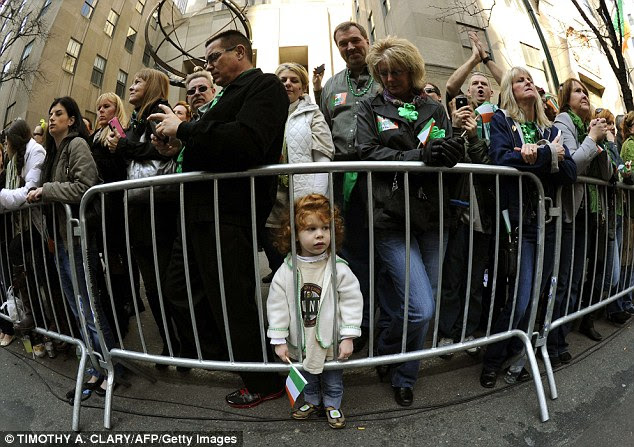
Patiently waiting: Across the street from St Patrick's Cathedral, spectators waited eagerly for the parade as well as a glimpse of their new cardinal, Timothy Dolan. As such, bars and liquor stores will close early, and additional officers will patrol the streets. Boston’s parade will begin at 1pm – liquor stores will shut there doors at 4pm, and bars have been ordered to close no later than 7:30pm this evening.
Far down south in Savannah, revelers set out folding chairs before dawn, and by the time the parade kicked off about 10 am in Georgia’s oldest city, they were piled three-deep on the sidewalks. Lines of thirsty patrons were spilling out of downtown bars before the pre-parade Mass wrapped up at the Cathedral of St. John the Baptist.

Appearance: Timothy Cardinal Dolan, Archbishop of New York made that appearance stepping out of the cathedral waving to the crowds

History: New York Mayor Michael Bloomberg greeted the archbishop on the day's parade which first took place on March 17 of 1762

Inviting: With the New York weather blanketing the crowds in a cool 60 degree morning, every assortment of spectator appeared to come out
'It’s ridiculous for still being in the am,' said Timmy Watkins, a utility worker from neighboring Rincon, who emerged from Pinkie Master’s Lounge with a beer in each hand after standing in line for 30 minutes. 'These are both mine. I waited in line long enough. I figured I’d get two.'
Started in 1856 by settlers who immigrated to the Georgia coast, the St. Patrick’s Day celebration has grown from a local procession with religious roots to a sprawling street party that’s Savannah’s biggest tourist draw of the year.
Local officials expected this year’s party to be one of the biggest yet, with the holiday falling on Saturday and postcard perfect weather — a sunny 76 degrees in the morning that was forecast to rise into the 80s.

Neighbours: Next door to New York, law enforcement in Morristown, New Jersey, took to the streets in green beards and top hats
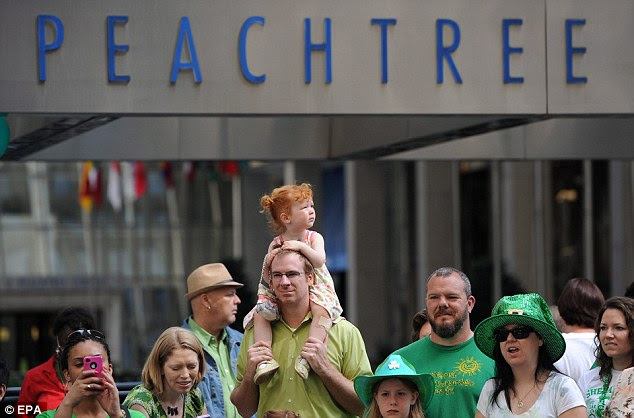
Lining up: Down south in Georgia, spectators eagerly waited a glimpse of Atlanta's 130th St. Patrick's Day Parade

St Patrick himself: A newly inflated St. Patrick helium balloon wafted in Atlanta's streets, waiting its parade debut

Cultural treat: An Irish dancer performed from toe to toe on one of the many parade floats in Atlanta
Northwest in Illinois, Chicago kept to its own annual tradition that brought out thousands of spectators to catch a glimpse of its river turned green.
Cheers erupted Saturday morning in the Windy City as a motor boat sped around in a circle and a man on board dumped the secret dye mixture that in minutes transforms the river into a psychedelic, vivid green.
Thousands gathered Saturday morning along the Chicago River, some in shamrock-shaped sunglasses and others dressed as leprechauns with strap-on orange beards.

Seeing green: In Illinois, the Chicago River was dyed green with the help of several speed boats for their annual festivities

Eye catching: The river's dye drew thousands along its bank this morning, with a few kayakers paddling in the water, to get a glimpse of the bright green water

Process: The Marina Towers loom in the background of a green Chicago river while boats ride back and forth on the river between Wabash and Columbus Avenues dropping the dye into the river

Holding hands: Irish Prime Minister Enda Kenny (left) walked Chicago's parade today with Mayor Rahm Emanuel
This year, the guest of honor was Irish Prime Minister Enda Kenny, who appeared at City Hall with Mayor Rahm Emanuel. Both men sported green ties and shamrocks in their lapels.
Mr Kenny says he's honoured to take part in Chicago's parade. He praised the city with a large Irish population for being so open and receptive to immigrants.
'It’s a real privilege for me, as leader of my country, to come to Chicago on this St. Patrick’s Day 2012 and participate in the parade,' Kenny said. 'And that’s a privilege that I shall remember for a long time.'

Pointed toes: Children in Detroit show off their Irish dancing skills in the annual parade
Curious: Two Detroit residents look out on the festivities (left) as a man proudly banishes the Irish flag. More than 100 St. Patrick’s Day parades will be held across the U.S. today, though New York and Boston boast the biggest and most elaborate celebrations. The often-besotted Hoboken parade in New Jersey was cancelled after city officials decided to move the event to a weekday in hopes of toning down the debauched behaviour. The celebration was notorious for partiers looking for an alternative to New York’s calm, family-friendly festivities. Forget the spring, here comes summer: Britain to bask in 17C temperatures all week (and that's hotter than Greece). The glorious weather is set to continue this week with temperatures hitting 17 degrees - five degrees up on normal and hotter than parts of Greece. People across the country having been taking advantage of the sunshine while temperatures reached highs of 17 (62F). Met Office forecaster George Goodfellow said it was set to be sunny and dry with similar temperatures throughout the week.

Riding out: Rachael Foister enjoys the hot weather and spring daffodils at West Dean College, West Sussex. Mr Goodfellow said: 'A band of high pressure coming from the north-west will stay with us this week bringing with it a spell of warm weather.
 young Jack Kennedy full of life and a mission to fulfill. jackie and john f kennedy Camelot ambiance in the Capitol
From his first day in office, Kennedy championed justice. In his January 20th Inaugural Address, he stated that, “In the long history of the world, only a few generations have been granted the role of defending freedom in its hours of maximum danger. I do not shrink from this responsibility, I welcome it.” In June 1963 President Kennedy stood at the infamous Berlin Wall, identifying in solidarity with his audience: “Ich bin ein Berliner.”John F. Kennedy sought to promote a better world, both at home and abroad. That was his Camelot: the promotion of heroes who rode forth to ensure universal justice.
The Long Terms Goals of the Camelot Presidency
For John F. Kennedy, the Roundtable Knights were the heroes – men and women that gave of themselves to achieve social justice and enrich the lives of others. These were the people who asked not what the country could do for them, but what they could do for their country. These were the Peace Corps volunteers, the scientists and technicians at NASA that implemented Project Mercury with the ultimate goal of putting a man on the moon, and the Civil Rights advocates that fought to end segregation in the South.
Although most of the initial Civil Rights legislation would be passed under the Presidency of Lyndon Johnson, it was the JFK administration that began the initiatives to end segregation. President Kennedy ended discrimination in federal housing and appointed blacks to high government positions. In June 1963 President Kennedy challenged the nation to live up to the “Golden Rule” and the American Dream as it affected all Americans, including people of color.
|
Gorbachev's attempts at reform — perestroika and glasnost — as well as summit conferences with United States President Ronald Reagan, contributed to the end of the Cold War, and also ended the political supremacy of the Communist Party of the Soviet Union (CPSU) and led to the dissolution of the Soviet Union. He was awarded the Nobel Peace Prize in 1990. Gorbachev is currently the leader of the Union of Social-Democrats[1], a political party founded after the official dissolution of the Social Democratic Party of Russia on October 20, 2007.
Early life
Gorbachev faced a very tough childhood under the totalitarian leadership of Joseph Stalin. His paternal grandfather was sentenced to nine years in the gulag for withholding grain from the collective's harvest.[2] He lived through World War II, during which, starting in August 1942, German troops occupied Stavropol. Although they left by February 1943, the occupation increased the hardship of the community and left a deep impression on the young Gorbachev.[3] From 1946 to 1950, he worked during the summers as an assistant combine harvester operator at the collective farms in his area.[3] He would take an increasing part in promoting peasant labour, which he describes as "very hard" because of enforced state quotas and taxes on private plots. Furthermore, as peasants were not issued passports, their only opportunity to leave their peasant existence was through enlisting in 'orgnabour' (organised recruitment) labour projects, which prompted Gorbachev to ask "what difference was there between this life and serfdom?".[4]
Gorbachev faced a very tough childhood under the totalitarian leadership of Joseph Stalin. His paternal grandfather was sentenced to nine years in the gulag for withholding grain from the collective's harvest.[2] He lived through World War II, during which, starting in August 1942, German troops occupied Stavropol. Although they left by February 1943, the occupation increased the hardship of the community and left a deep impression on the young Gorbachev.[3] From 1946 to 1950, he worked during the summers as an assistant combine harvester operator at the collective farms in his area.[3] He would take an increasing part in promoting peasant labour, which he describes as "very hard" because of enforced state quotas and taxes on private plots. Furthermore, as peasants were not issued passports, their only opportunity to leave their peasant existence was through enlisting in 'orgnabour' (organised recruitment) labour projects, which prompted Gorbachev to ask "what difference was there between this life and serfdom?".[4]
Political career
Despite the hardship of his background, Gorbachev excelled in the fields and in the classroom. He was considered one of the most intelligent in his class [2], with a particular interest in history and mathematics. After he left school he helped his father harvest a record crop on his collective farm. As a result, he was awarded the Order of the Red Banner of Labour, at just 16 (1947). It was rare for someone his age to be given such an honour. It was almost certain that this award, coupled with his intelligence, helped secure his place at Moscow University, where he studied law from September 1950.[3] Gorbachev may never have intended to practice law, however he simply may have seen it as preparation for working in the Communist Party of the Soviet Union (CPSU). He became a candidate member of the Party that same year.[3] While living in Moscow, he met his future wife, Raisa Maksimovna Titarenko.[3] They married on 25 September 1953 and moved to Gorbachev's home region of Stavropol in southern Russia when he graduated in June 1955, where he immersed himself in party work.[3] Upon graduating, he briefly worked in the Prokuratura (Soviet State Procuracy) before transferring to the Komsomol, or Communist Union of Youth. He served as First Secretary of the Stavropol City Komsomol Committee from September, 1956, later moving up to the Stavropol Krai (regional) Komsomol Committee, where he worked as Second Secretary from April 1958 and as First Secretary from March 1961.[3] Raisa would give birth to their first child, a daughter named Irina, on 6 January 1957
Despite the hardship of his background, Gorbachev excelled in the fields and in the classroom. He was considered one of the most intelligent in his class [2], with a particular interest in history and mathematics. After he left school he helped his father harvest a record crop on his collective farm. As a result, he was awarded the Order of the Red Banner of Labour, at just 16 (1947). It was rare for someone his age to be given such an honour. It was almost certain that this award, coupled with his intelligence, helped secure his place at Moscow University, where he studied law from September 1950.[3] Gorbachev may never have intended to practice law, however he simply may have seen it as preparation for working in the Communist Party of the Soviet Union (CPSU). He became a candidate member of the Party that same year.[3] While living in Moscow, he met his future wife, Raisa Maksimovna Titarenko.[3] They married on 25 September 1953 and moved to Gorbachev's home region of Stavropol in southern Russia when he graduated in June 1955, where he immersed himself in party work.[3] Upon graduating, he briefly worked in the Prokuratura (Soviet State Procuracy) before transferring to the Komsomol, or Communist Union of Youth. He served as First Secretary of the Stavropol City Komsomol Committee from September, 1956, later moving up to the Stavropol Krai (regional) Komsomol Committee, where he worked as Second Secretary from April 1958 and as First Secretary from March 1961.[3] Raisa would give birth to their first child, a daughter named Irina, on 6 January 1957

In 1960 he won the Democratic nomination for president, beating out Lyndon B. Johnson, who became his running mate. In his acceptance speech Kennedy declared, We stand on the edge of a New Frontier; thereafter the phrase New Frontier was associated with his programs. After a vigorous campaign managed by his brother Robert F. Kennedy and aided financially by his father, he narrowly defeated the Republican candidate, Richard Nixon. He was the youngest person and the first Roman Catholic elected president. In his inaugural address he called on Americans to ask not what your country can do for you, ask what you can do for your country. His legislative program, including massive income-tax cuts and a sweeping civil-rights measure, received little support in the Congress, though he did win approval of the Peace Corpsand the Alliance for Progress. In 1961 he committed the U.S. to land a man on the Moon by the end of the decade. In foreign affairs he approved a plan drawn up during the Eisenhower administration to land an invasion force of Cuban exiles on their homeland, but the Bay of Pigs invasion (1961) was a fiasco. Determined to combat the spread of communism in Asia, he sent military advisers and other assistance to South Vietnam. During the Cuban missile crisis (1962) he imposed a naval blockade on Cuba and demanded that the Soviet Union remove its nuclear missiles from the island.

WWII Paris June 14, 1945 Generals De Gaulle and Eisenhower. General DeGaulle awarding General Eisenhower the Croix de la Liberation at the Arc de Triumph ceremony, June 14, 1945.

Prince Harry appears to be sharing a joke with photographers as he gets into his Apache helicopter during early morning pre-flight checks

Prince Harry chats to reporters and a TV crew following the checks on his aircraft

During his deployment his colleagues and superiors hailed him for fitting into his unit well and being 'on top of his game' during the 'extremely busy' and dangerous tour



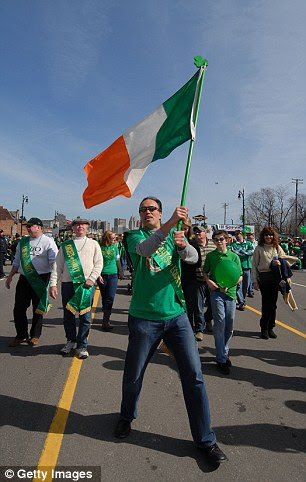
No comments:
Post a Comment